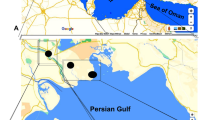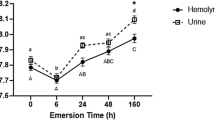Abstract.
Fiddler crabs (Crustacea: Decapoda; genus Uca) were collected from 16 locations along the temperate Atlantic and Gulf of Mexico coasts of eastern North America for osmoregulation studies. Three species, U. pugilator, U. pugnax and U. minax, were taken from habitats between Cape Cod, MA, and St. Mary's River, Nassau Co., GA Seven species, U. panacea, U. speciosa, U. spinicarpa, U. longisignalis, U. rapax, U. pugilator and U. minax, were collected in habitats between the Ochlochonee River, Liberty Co., and Thompson's Bayou, Escambia Co., along the Gulf coast of northwest Florida. To examine differences in osmoregulatory capabilities among the species, specimens were placed in various concentrations of artificial seawater (0–3450 mOsm) for 5 days. The oligohaline or "freshwater" species, U. minax, U. spinicarpa and U. longisignalis, possess the lowest average hemolymph osmolality. They are unable to control hemolymph osmolality above 2000 mOsm. On the other hand, the euryhaline species, U. speciosa, U. panacea, U. pugilator and U. pugnax, have much higher average hemolymph osmolality. They are able to withstand an osmotic challenge of 2200 mOsm or greater. Among the eight species, U. panacea and U. pugilator are able to osmoregulate across the broadest range of seawater concentrations (0–2800 mOsm). After an examination of the osmoregulation in several populations of U. minax, U. pugilator and U. pugnax, physiological adaptation is apparent in the two former species, but not the latter. Experimental evidence for capacity adaptation was examined in the freshwater species, U. minax. If slowly adapted to hypertonic seawater (1800 mOsm) for 14 days, this species is able to withstand much higher osmotic pressures than unadapted crabs. Although hemolymph isosmotic concentration remains the same, the limits for regulation are extended to higher osmolality. Consequently, as a result of studying osmoregulation in several species of Uca captured at various locations across their geographic range in the temperate zone, a clearer view of water-balance physiology is available for the genus. The Uca spp. are not uniform in osmoregulatory abilities. There is considerable inter- and intraspecific physiological variation associated with the ecological distribution of each species, respectively.
Similar content being viewed by others
Author information
Authors and Affiliations
Additional information
Electronic Publication
Rights and permissions
About this article
Cite this article
Thurman, .C. Osmoregulation in fiddler crabs (Uca) from temperate Atlantic and Gulf of Mexico coasts of North America. Marine Biology 142, 77–92 (2003). https://doi.org/10.1007/s00227-002-0920-8
Received:
Accepted:
Issue Date:
DOI: https://doi.org/10.1007/s00227-002-0920-8




